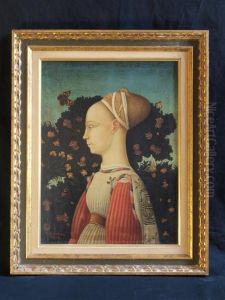Antonio Di Puccio Pisano Paintings
Antonio di Puccio Pisano, also known as Pisanello, was an Italian painter and medallist of the early Renaissance, known for his works in both fresco and panel painting, as well as his superbly crafted portrait medals. He was born around 1395 in Pisa, although some sources suggest he was born in Verona. Pisanello's life is not well-documented, and much of what is known about him comes from the works he left behind.
Pisanello became a prominent figure in the courts of Northern Italy, where he gained fame for his delicate and intricate style, which showcased a keen attention to detail and a fascination with the natural world. His work often featured a mix of courtly subjects, such as princes and nobles, as well as studies of animals and plants, reflecting the courtly interest in nature and chivalry of the time.
One of the earliest known works attributed to Pisanello is the Annunciation fresco in the St. Fermo church in Verona, which he may have completed around 1424. He also worked on frescoes in the Basilica di Sant'Anastasia in Verona around the same time. In 1435, he traveled to Ferrara to work at the court of Marquis Leonello d’Este, a notable patron of the arts. It was here that Pisanello produced one of his most famous frescoes, 'The Legend of St. George and the Princess,' which is celebrated for its detailed and lively depiction of a chivalric legend.
Pisanello is also credited with pioneering the art of the portrait medal, a form that became highly popular in Renaissance courts. His medals were cast in various metals and featured profiles of his patrons and their associates, much like the profile portraits on ancient Roman coins. These medals are considered some of the finest examples of the medium from the Renaissance period.
Pisanello's work fell into obscurity for several centuries before being rediscovered in the 19th century. Today, he is appreciated for his role in the development of Italian Renaissance art, particularly for his contribution to the art of portraiture and for his delicate naturalistic studies. He is believed to have died around 1455, possibly in Mantua, but the exact circumstances of his death are unknown.
